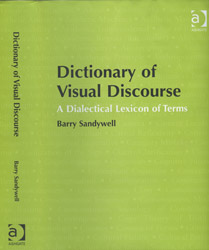Dictionary of Visual Discourse
Paul Taylor, University Centre Croydon
Sandywell, B. (2011), Ashgate Publishing Limited. .......... In the age of the Internet, in which information and facts can be sourced almost instantly, it becomes questionable whether a ‘tome’ of over 700 pages dealing with idioms from ‘abschattungen’ to ‘zykt’, a lexicon of terms, fulfills a necessary or functional purpose. However, reassuringly, this book is also available as an e-book and ...
 Author:Barry Sandywell
Author:Barry Sandywell
Publisher: Ashgate Publishing Limited
Publication date: 2011
ISBN: 978-1-4094-0188-9 (hardcover) 978-1-4094-0189-6 (e-book)
Price: £120.00 / £108.00 (e-book)
In the age of the Internet, in which information and facts can be sourced almost instantly, it becomes questionable whether a ‘tome’ of over 700 pages dealing with idioms from ‘abschattungen’ to ‘zykt’, a lexicon of terms, fulfills a necessary or functional purpose.
However, reassuringly, this book is also available as an e-book and the author perhaps defines the relevance of the printed word by quoting from Heinrich Heine, Emerson, Nietzsche and Gadamer as a preface to the introduction, and includes the aphorism ‘words have created the world ’, perhaps alluding to the value of the printed word in the form of a book? And it is in the introduction or prologue that the author excels in a series of short essays that define the parameters of the rest of the work by dealing with such seminal issues as, for instance, ‘Experience in a Thanatonic Age’, ‘Ritual to Political Aesthetics’, ’Re-inventing Visual Culture’, ‘Future Thought’ and other useful, more than sufficiently explained and referenced aspects of current cultural theory and language.
In these introductory passages Sandywell asks a series of questions such as ‘how should we reflect upon and understand the terms of vision?’ ‘Is it possible to disclose the hidden order behind the new visual culture?’ and ‘How, in other words, should we think the visual?’ These opening sections, and the addition of two further introductory chapters ‘Preview and Methodology’ and ‘Thematic Orientations’ further serve to define the purpose and functionality of a Dictionary of Terms. Both inform and explain wide ranging aspects of current thinking, the debates in visual culture and the philosophical deliberations that surround, and most importantly inform, the visual arts.
The bulk of this volume, over five hundred pages, forms the basis of any researcher’s quick reference for a multitude of dialectical knowledge, description of commonplace concepts, languages, cultures and sometimes obscure terms (as already mentioned ‘abschattungen’ to ‘zykt’) Each entry is authoritative and incorporates inter-textual links which, in the main, fully explore the concept, meaning and range of the topic. For instance, the entry on ‘Perception’ as a ‘many dimensional term’ (over five pages), cross references to ‘Epistemology: Idea: Representation: Sensation and Ideology’, ends with a lengthy quote from Sartre and suggestions for further research including ‘Perpectivism’ ‘Rashomon Effect’ and, for good measure, ‘abschattungen’. Via the Harvard system each entry engages the reader with an impressive bibliography (one hundred and eighty five pages) and sets a paradigm for good practice and further study, particularly useful for undergraduate students and other researchers.
However the entry on Structuralism (a mere one page) seems rather short, but nevertheless serves its purpose, with profuse referencing and recommendations in the generous and lengthy bibliography. For instance, there are thirteen references to Foucault’s published work although there is no entry that might have summarized his philosophy (but that of course would be more appropriately found in a dictionary of western philosophy or of modern thought?).
Overall this work is an enjoyable experience, formative in constructing arguments and debates surrounding visual rhetoric, and where student, lecturer or researcher within the creative arts is challenged to find authoritative and easily understood explanations of discourse, commonly used in studio practice, tutorials and theoretical guidance.
It more than provides understanding of the complexities and motivations of current academic thinking surrounding theoretical and academic discourse, as well as the visual culture engaged in everyday life. Also, as mentioned, the exhaustive bibliography serves in itself to inform and instigate further research as the reader delves into subject matter. This firmly places the work in the context of contemporary thought, working as an interdisciplinary guide to the vocabularies and grammar, the philosophical understanding, theories and other frameworks that are essential reading for practitioners and scholars in a wide range of creative disciplines, including art history, film, media and communication studies, sociology of visual culture.
It comes highly recommended as an addition to Art and Design libraries, but will find students, lecturers and researchers from a wider range of disciplines using it as essential reading. It stands as a lucid, intellectual, substantially comprehensive survey and academic contribution to contemporary thought in the field of visual studies, as well as a formidable contribution to the language of visual discourse.
Reviewer
Paul Taylor is Programme Leader: Art, Design & Media at University Centre Croydon.


